从功能语法角度看语法隐喻
- 格式:pdf
- 大小:42.63 KB
- 文档页数:10

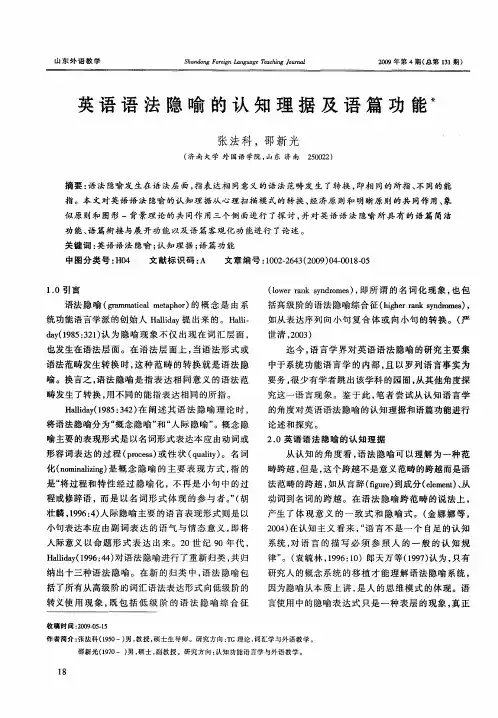

系统功能语言学视阈的语法隐喻研究
隐喻是人类思维和语言表达的重要手段和语言交际的必要元素之一。
在语法领域中,隐喻不仅存在于词汇和句子结构中,还存在于语法规则之中。
隐喻语法规则的研究范式和方法主要有以下几种:
1. 语法化隐喻的研究
语法化隐喻是指隐喻在语言中得到了广泛应用,形成了一定的语法体系。
传统的语法规则只关注语法形式和结构,但在语法化隐喻中,语法规则本身就是一种表达方式。
例如,汉语的“是…的”结构就是一种语法化的隐喻,表示修辞强调和信息重心移动的效果。
2. 语法类型隐喻的研究
语法类型隐喻是指隐喻在不同语法类型中的应用。
例如,在英语中,名词短语可以用作句子主语或宾语,这种语法结构可以通过隐喻来表达不同的意义。
例如,“计算机是一只猫”和“计
算机是一所学校”中的隐喻使用了名词短语作为主语和宾语。
3. 语法结构隐喻的研究
语法结构隐喻是指隐喻在句子结构中的应用。
例如,在汉语中,“把”字结构可以表达一种动作的主观意图,例如“我把电影看
完了”中的“把”字结构表达了主观意图“看完”,而不是动作本身。
总之,通过语法隐喻的研究可以更深入地理解语言的表达方式和思维方式,为语言教学和翻译工作提供重要的理论基础。

英语中的人际语法隐喻语法隐喻,作为一种重要的语言现象,广泛存在于各种文体中。
其中,名词化语法隐喻在科技英语中尤为常见,它在构建科技英语语篇的衔接和连贯性方面起着关键作用。
本文将探讨名词化语法隐喻及其在科技英语中的语篇衔接功能。
名词化语法隐喻是指通过使用名词或名词短语来表达动词或形容词的含义,从而使语言更加简洁、客观、专业。
在科技英语中,由于需要描述复杂的概念和过程,名词化语法隐喻的使用尤为常见。
构建语义关系:名词化语法隐喻在科技英语中可以用来构建语义关系,使语篇中的句子之间更加连贯。
例如,使用名词化的动词短语“施行手术”可以简洁地表达“做手术”的含义,使句子之间的更加紧密。
提升信息密度:名词化语法隐喻还可以提高语篇的信息密度。
通过将复杂的动作或状态抽象为名词,科技英语可以更有效地传递信息。
例如,“执行任务”这个名词化短语可以简洁地表达“完成任务”的含义,大大提高了信息密度。
增强客观性:名词化语法隐喻的使用可以增强科技英语的客观性。
通过将主观感受或动作转化为客观的名词,名词化语法隐喻可以让读者更加清晰地理解作者的意图,减少主观因素的影响。
提高表达效率:在科技英语中,名词化语法隐喻的使用可以提高表达效率。
使用名词化的短语可以减少冗余的表述,使语言更加简洁明了。
例如,“进行实验”这个短语就比用“做实验”更加简洁高效。
名词化语法隐喻在科技英语中扮演着重要的角色,它不仅可以帮助构建语义关系、提升信息密度、增强客观性,还可以提高表达效率。
对于科技英语的学习者和使用者来说,理解并掌握名词化语法隐喻是提高阅读和写作能力的重要一环。
在翻译研究中,语法隐喻一直是一个备受的话题。
语法隐喻作为一种语言现象,指的是通过改变语法形式来表达不同的语义和语用功能。
在翻译过程中,语法隐喻为译者提供了一种重要的工具,可以帮助他们更好地理解和转换源语言和目标语言之间的意义。
本文将探讨语法隐喻在翻译研究中的重要性及其应用。
语法隐喻的基本原理在于通过改变语法形式来表达不同的意义。
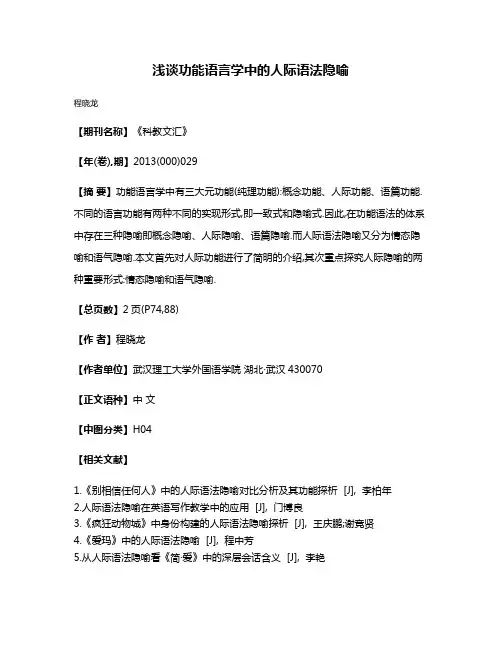
浅谈功能语言学中的人际语法隐喻
程晓龙
【期刊名称】《科教文汇》
【年(卷),期】2013(000)029
【摘要】功能语言学中有三大元功能(纯理功能):概念功能、人际功能、语篇功能.不同的语言功能有两种不同的实现形式,即一致式和隐喻式.因此,在功能语法的体系中存在三种隐喻即概念隐喻、人际隐喻、语篇隐喻.而人际语法隐喻又分为情态隐喻和语气隐喻.本文首先对人际功能进行了简明的介绍,其次重点探究人际隐喻的两种重要形式:情态隐喻和语气隐喻.
【总页数】2页(P74,88)
【作者】程晓龙
【作者单位】武汉理工大学外国语学院湖北·武汉430070
【正文语种】中文
【中图分类】H04
【相关文献】
1.《别相信任何人》中的人际语法隐喻对比分析及其功能探析 [J], 李柏年
2.人际语法隐喻在英语写作教学中的应用 [J], 门博良
3.《疯狂动物城》中身份构建的人际语法隐喻探析 [J], 王庆鹏;谢竞贤
4.《爱玛》中的人际语法隐喻 [J], 程中芳
5.从人际语法隐喻看《简·爱》中的深层会话含义 [J], 李艳
因版权原因,仅展示原文概要,查看原文内容请购买。

MING RI FENG SHANG287社 会 视 野文|周 雪系统功能语言学中的语法隐喻理论的发展摘要:“语法隐喻”这一概念是由韩礼德在1976年首次提出的,提出以来语法隐喻成为语言学界的研究热点。
语法隐喻在系统功能语言学中占据了基础地位,它是语义层与词汇语法层的重要联结方式。
本文首先介绍了经典语法隐喻理论,然后阐述了语法隐喻的发展阶段,希望对研究系统功能语言学的语法隐喻的学习者有一定的帮助。
关键词:系统功能语言学;语法隐喻;发展一、引言语法隐喻一词最早是由系统功能语言学家韩礼德提出的,即“隐喻现象并不仅限于词汇层面,而且经常发生在语法层面”并且他将语法隐喻分为概念语法隐喻和人际语法隐喻两大类。
国内也有一些语言学家或学者从不同的方面对语法隐喻理论进行了进一步的完善和发展。
例如:朱永生和严世清阐述了语法隐喻理论的根据,他们还揭示了当代隐喻研究的意义以及贡献(朱永生,严世清,2000);胡壮麟也对韩礼德的语法隐喻的一些框架的不彻底性提出讨论(胡壮麟,2000);常晨光也对韩礼德提出的人际语法隐喻进行再分析(常晨光,2001)。
本文主要对语法隐喻的发展进行详细阐述,并就语法隐喻的一些问题进行相关的讨论。
二、语法隐喻的发展“语法隐喻”这个概念首次出现在韩礼德1976年发表的论文《反语言》中,而语法隐喻的发展事实上历经了三个阶段:1、第一阶段这一阶段是语法隐喻的萌芽阶段,以韩礼德的《反语言》和《英汉语中的语法隐喻》这两篇论文为代表作。
在《反语言》中,韩礼德认为“反语言”是日常语言的一种隐喻形式,并且隐喻可以在语言系统的各个层面出现,如语音隐喻、语法隐喻、以及语义隐喻,语法隐喻可以进一步分为词法、词汇和句法隐喻三种。
韩礼德还指出,语言的基本属性之一就是语法隐喻,在日常生活中的语言大部分是隐喻性的。
但此时的这些理论观点还未成熟,缺乏具体的论证。
随后,在1984年的《英汉语中的语法隐喻》这一论文中,韩礼德开始解决上面阐述的问题。
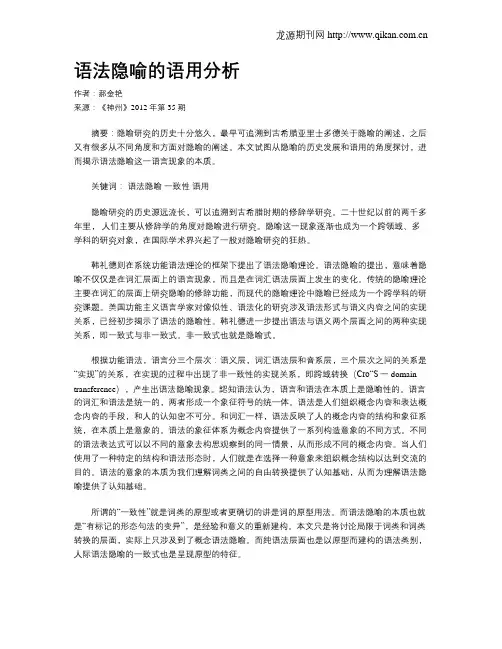
语法隐喻的语用分析作者:郝金艳来源:《神州》2012年第35期摘要:隐喻研究的历史十分悠久,最早可追溯到古希腊亚里士多德关于隐喻的阐述,之后又有很多从不同角度和方面对隐喻的阐述。
本文试图从隐喻的历史发展和语用的角度探讨,进而揭示语法隐喻这一语言现象的本质。
关键词:语法隐喻一致性语用隐喻研究的历史源远流长,可以追溯到古希腊时期的修辞学研究。
二十世纪以前的两千多年里,人们主要从修辞学的角度对隐喻进行研究。
隐喻这一现象逐渐也成为一个跨领域、多学科的研究对象,在国际学术界兴起了一股对隐喻研究的狂热。
韩礼德则在系统功能语法理论的框架下提出了语法隐喻理论。
语法隐喻的提出,意味着隐喻不仅仅是在词汇层面上的语言现象,而且是在词汇语法层面上发生的变化。
传统的隐喻理论主要在词汇的层面上研究隐喻的修辞功能,而现代的隐喻理论中隐喻已经成为一个跨学科的研究课题。
美国功能主义语言学家对像似性、语法化的研究涉及语法形式与语义内容之间的实现关系,已经初步揭示了语法的隐喻性。
韩礼德进一步提出语法与语义两个层面之间的两种实现关系,即一致式与非一致式。
非一致式也就是隐喻式。
根据功能语法,语言分三个层次:语义层,词汇语法层和音系层,三个层次之间的关系是“实现”的关系,在实现的过程中出现了非一致性的实现关系,即跨域转换(Cro“S一domain transference),产生出语法隐喻现象。
認知语法认为,语言和语法在本质上是隐喻性的。
语言的词汇和语法是统一的,两者形成一个象征符号的统一体。
语法是人们组织概念内容和表达概念内容的手段,和人的认知密不可分。
和词汇一样,语法反映了人的概念内容的结构和象征系统,在本质上是意象的。
语法的象征体系为概念内容提供了一系列构造意象的不同方式。
不同的语法表达式可以以不同的意象去构思观察到的同一情景,从而形成不同的概念内容。
当人们使用了一种特定的结构和语法形态时,人们就是在选择一种意象来组织概念结构以达到交流的目的。
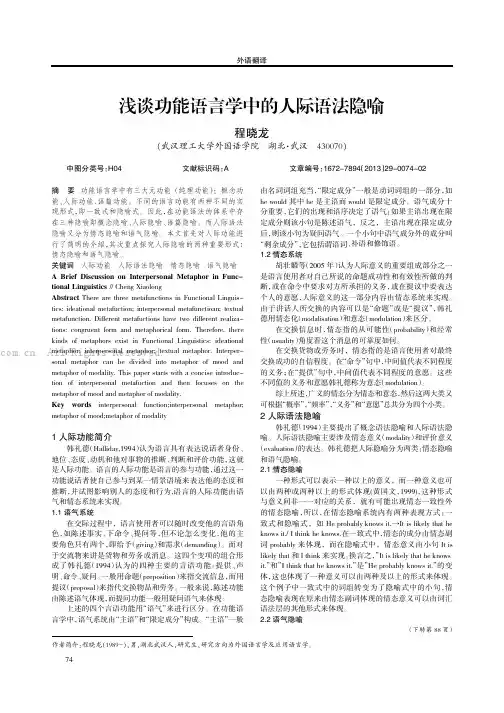
浅谈功能语言学中的人际语法隐喻程晓龙(武汉理工大学外国语学院湖北·武汉430070)中图分类号:H04文献标识码:A 文章编号:1672-7894(2013)29-0074-02作者简介:程晓龙(1989-),男,湖北武汉人,研究生,研究方向为外国语言学及应用语言学。
摘要功能语言学中有三大元功能(纯理功能):概念功能、人际功能、语篇功能。
不同的语言功能有两种不同的实现形式,即一致式和隐喻式。
因此,在功能语法的体系中存在三种隐喻即概念隐喻、人际隐喻、语篇隐喻。
而人际语法隐喻又分为情态隐喻和语气隐喻。
本文首先对人际功能进行了简明的介绍,其次重点探究人际隐喻的两种重要形式:情态隐喻和语气隐喻。
关键词人际功能人际语法隐喻情态隐喻语气隐喻A Brief Discussionon Interpersonal Metaphor in Func 原tional Linguistics //Cheng Xiaolong Abstract There are three metafunctions in Functional Linguis-tics:ideational metafuction;interpersonal metafunctioan;textual metafunction.Different metafuctions have two different realiza-tions:congruent form and metaphorical form.Therefore,there kinds of metaphors exist in Functional Linguistics:ideational metaphor;interpersonal metaphor;textual metaphor.Interper-sonal metaphor can be divided into metaphor of mood and metaphor of modality.This paper starts with a concise introduc-tion of interpersonal metafuction and then focuses on the metaphor of mood and metaphor of modality.Key words interpersonal function;interpersonal metaphor;metaphor of mood;metaphor of modality 1人际功能简介韩礼德(Halliday,1994)认为语言具有表达说话者身份、地位、态度、动机和他对事物的推断、判断和评价功能,这就是人际功能。
![[语法隐喻与认知概念隐喻之比较] 概念语法隐喻](https://uimg.taocdn.com/f950fc5b1a37f111f0855b1a.webp)
《[语法隐喻与认知概念隐喻之比较] 概念语法隐喻》摘要:本文分别从系统功能语法的角度和认知语言学的角度对隐喻进行了比较,比较隐喻是一种语言现象,我们可以在语言发展的规律中发现隐喻的作用,从系统功能语言学来看,语法隐喻有修辞、语言学、认知和社会等功能(束定芳,2000)摘要: 本文分别从系统功能语法的角度和认知语言学的角度对隐喻进行了比较。
二者具有不同的讲究方法和目的,但并非一个优于另一个而是相互补充。
从多维度去研究隐喻,有助于我们全面地理解和解释隐喻。
关键词: 隐喻认知语言学系统功能语法比较隐喻是一种语言现象,我们可以在语言发展的规律中发现隐喻的作用。
隐喻同时又是一种认知现象,它与人类的思维方式和思维发展过程密切相关。
因此,语言学上对隐喻的研究一般分成两个派别,一派是功能主义语言学派,特别是系统功能语言学派,最早提出语法隐喻概念的是系统功能语法的创始人Hallidy(1985)。
后来的系统功能学派的Ravelli,Martin和Goatly等学者发展了这一理论。
另一派是认知语言学派,如Lakoff,Johnson和Langacker等从认知思维的角度研究隐喻,探讨认知与语言的关系,将隐喻看作是对新事物和抽象概念进行概念化的方式,是概念系统中跨认知域的投射。
一、语法隐喻和认知概念隐喻Halliday在1985年和1994年两个版本的《功能语法入门》中提出了“语法隐喻”的理论。
他认为,在语言形成和发展初期,现实世界似乎是通过隐喻化过程体现一定的语法形式。
系统功能语言学将语言看作是一个多层次的系统(a system of systems),即语义层、词汇语法层(lexicogrammar)、语音层,而且从下至上是一种体现关系。
但词汇语法层对语义层是多元体现关系,即一种语义可以由多种不同的词汇语法形式来体现,也就是用一种概念来表达一种或多种概念,而且需要它们之间的相互联系和互动。
根据Halliday的语言元功能理论,语言形式对语义的体现表现在两个功能方面:概念功能和人际功能。
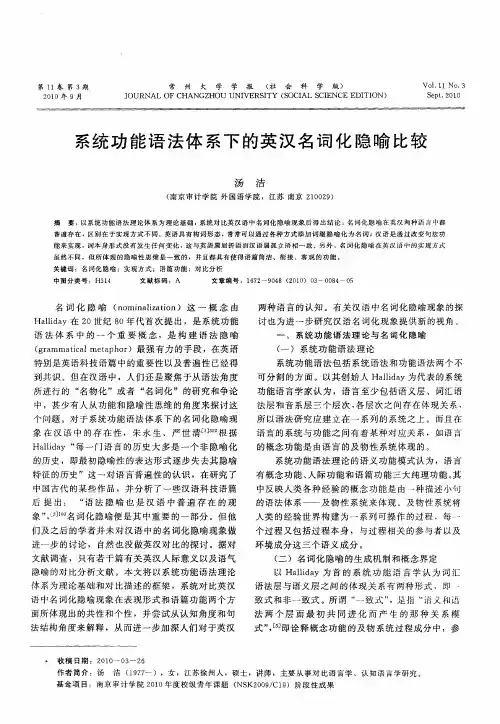
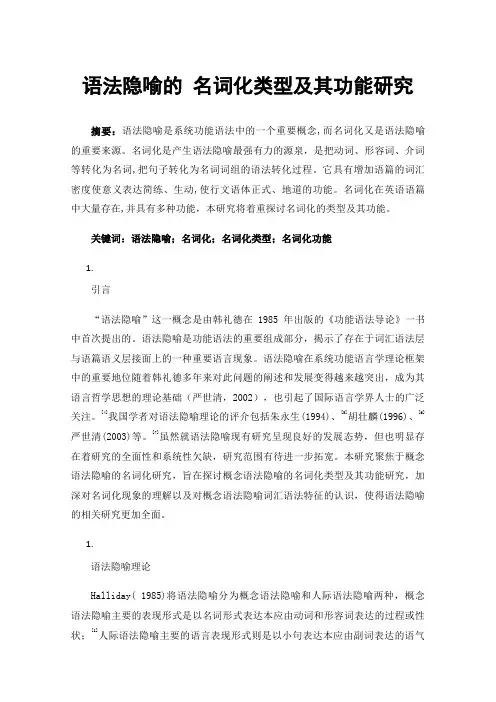
语法隐喻的名词化类型及其功能研究摘要:语法隐喻是系统功能语法中的一个重要概念,而名词化又是语法隐喻的重要来源。
名词化是产生语法隐喻最强有力的源泉,是把动词、形容词、介词等转化为名词,把句子转化为名词词组的语法转化过程。
它具有增加语篇的词汇密度使意义表达简练、生动,使行文语体正式、地道的功能。
名词化在英语语篇中大量存在,并具有多种功能,本研究将着重探讨名词化的类型及其功能。
关键词:语法隐喻;名词化;名词化类型;名词化功能1.引言“语法隐喻”这一概念是由韩礼德在1985年出版的《功能语法导论》一书中首次提出的。
语法隐喻是功能语法的重要组成部分,揭示了存在于词汇语法层与语篇语义层接面上的一种重要语言现象。
语法隐喻在系统功能语言学理论框架中的重要地位随着韩礼德多年来对此问题的阐述和发展变得越来越突出,成为其语言哲学思想的理论基础(严世清,2002),也引起了国际语言学界人士的广泛关注。
[4]我国学者对语法隐喻理论的评介包括朱永生(1994)、[5]胡壮麟(1996)、[6]严世清(2003)等。
[7]虽然就语法隐喻现有研究呈现良好的发展态势,但也明显存在着研究的全面性和系统性欠缺,研究范围有待进一步拓宽。
本研究聚焦于概念语法隐喻的名词化研究,旨在探讨概念语法隐喻的名词化类型及其功能研究,加深对名词化现象的理解以及对概念语法隐喻词汇语法特征的认识,使得语法隐喻的相关研究更加全面。
1.语法隐喻理论Halliday( 1985)将语法隐喻分为概念语法隐喻和人际语法隐喻两种,概念语法隐喻主要的表现形式是以名词形式表达本应由动词和形容词表达的过程或性状;[1]人际语法隐喻主要的语言表现形式则是以小句表达本应由副词表达的语气与情态意义,即将人际意义以命题形式表达出来。
对名词化现象较早进行解释的是Jespersen,但其研究主要集中于句子层面,而未能扩展到语篇角度,且对名词化的分类过于狭窄。
Quirk等人(1985)从词性转换的角度对名词化作过界定,把它看作是“一个在形态上与小句谓语相对应的名词短语”。
研究生论丛2005年5月湘潭大学学报(哲学社会科学版)Journal of X iangtan U n i versity(Ph ilosophy and Soc i a l Sc i ences)V o.l29M ay,2005谈三种隐喻观的比较)))修辞隐喻、认知隐喻和语法隐喻姚婵莉(湘潭大学外国语学院,湖南湘潭411105)一、引言近几年来,隐喻研究的浪潮已经波及到中国,国内一些主要外语类学术刊物刊登了许多介绍国外研究成果的文章,甚至有人开始着手创建隐喻学(束定芳,1996)。
隐喻在起初的最基本意义只是一种修辞手法,是一种扭曲词语常规意义的语言或思维形式。
隐喻通过把一个领域的概念,思想和术语应用到其它领域来修饰文章。
关于隐喻的讨论自柏拉图、亚里斯多德就开始了,尽管他们已经认识到隐喻的重要作用,但对于隐喻的效果更多是消极的评价,隐喻在当时只是作为艺术性表达和哲学辩论的工具。
L akoff&Johnson扩展了隐喻概念的内涵,赋予隐喻新的诠释和评价,提出了隐喻的认知理论。
隐喻植根于日常生活当中,与日常生活息息相关,是运用语言和思维的基础。
所以隐喻不能简单地作为一个修辞工具来使用,作为语言的一部分它组成了构建我们存在模式的载体[2]。
研究表明,语言多义性和创造性是基于隐喻的,生活中处处是隐喻的使用。
本文试对修辞隐喻,认知隐喻和语法隐喻的三个层面:隐喻本质认识,隐喻机制和功能的比较来展示隐喻研究多维立体化的现状并揭示其互补性。
二、隐喻的本质比较1.修辞隐喻的本质观毫无疑问,历史上第一位对隐喻现象进行系统论述的是亚里斯多德。
在5修辞学6和5诗学6中他多处论及了隐喻。
亚里斯多德对隐喻的定义是:隐喻通过把属于别的事物的词给予另一个事物而构成,或从/属0到/种0,或从/种0到/属0,或从/种0到/种0,或通过类比(A risto tl e,P oetics: 1457b)。
亚里斯多德的定义似乎属于第二类,即从隐喻的活动方式角度来描述隐喻的特征。
语法隐喻与视点中文从古希腊时期,人们就开始探索隐喻之谜。
但是,古往今来,研究主要是从修辞角度出发,在词汇层面上进行的,而对语法隐喻研究却很少。
近二十年来,许多学者注意到语法层面上也存在着隐喻现象并对此进行了大量的研究。
作者在系统功能语言的框架下,对语法隐喻这一重要现象进行研究时,发现它和视点之间存在着一定的关系。
本论文正是基于此点对语法隐喻和视点之间的关系进行了探索性的研究。
首先,作者在回顾前人研究的情况下,简约介绍了一些系统功能语法学家对语法隐喻的不同定义及观点,并以韩礼德对语法隐喻的理解为基础,提出了语法隐喻的概念,认为"语法隐喻是意义的不同体现,它涉及语法范畴从一个语法域到另一个语法域的转移"并把语法隐喻分为概念语法隐喻、人际语法隐喻和语篇语法隐喻。
接着,作者转向对视点的研究。
视点起源于文学批评理论,原指故事讲述者组织故事时的一种心理倾向,分为时间视点、空间视点、观念视点和心理视点。
这里,作者所研究的则指的是说话者或语篇建构者看待世界的角度和态度。
当视点在语法结构上没有体现人们把握世界的惯常逻辑顺序或认知顺序时,就可能出现语法隐喻。
而后,作者着重研究了视点在概念语法隐喻和人际语法隐喻方面起的作用,得出这两种语法隐喻均可体现视点,也就是说,说话人或语篇建构者的心理角度或态度可由其所运用的语法隐喻中得到体现。
这一发现补充了前人的研究,发展了语法隐喻理论。
译文As is known, ever since Aristotle people have been interested in and doing a lot of research on metaphor, but most of the studies of metaphor have been mainly concerned with metaphor in its rhetorical sense. Though some linguists have realized the metaphorical nature of grammar, research on grammatical metaphor (GM) is rare. It was with the systemic-functionalists that the conscious study of GM started. Yet, studies on GM are far from being enough. It is found that there is certain relationship between GM and point of view. Therefore, the dissertation ventures to make some exploration on the relationship between GM and point of view. Following the introduction, the second chapter presents some systemic-functionalists' different views and treatments of GM. It was Halliday's idea of GM that marked the beginning of the theoretical study on GM. Ever since then, quite a lot of systemic-functionalists, namely, Ravelli, Martin, Mattiessen and Goatly, have taken up the topic and made their contributions to it, which are of great importance to the study of GM. Based on Halliday's treatment of GM as transferred realizations in the lexicogrammar and other researchers'approaches, GM is regarded as an incongruent realization of meanings involving transference of grammatical units from onegrammatical domain to another, and it is divided into three kinds: ideational GM, interpersonal GM and textual GM. Then, the dissertation turns to the research of point of view in the third chapter. Point of view is derived from stylistic criticism and defined as "the psychological perspective through which a story is told (Fowler, 1986: 112)". Simpson transferred the concept of point of view to linguistics and identified four important categories: spatial and temporal point of view, ideological point of view and psychological point of view. This dissertation specifically focuses on the angel and attitude people hold as they encode the world. GM may go into existence when point of view is not in accordance with the usual logical sequence on the grammatical level people have to look at the world. And point of view can determine grammatical variation in a discourse through the employment of metaphorical realization. Since ideational metaphor and nterpersonal metaphor are correlated to point of view closely, the following two chapters deal with it respectively. By ideational metaphor, especially by nominalization, it is likely to package information, create special texture, achieve discoursal and stylistic effects, and show ideological trends; the employment of the two types of interpersonal metaphor, metaphors of mood and metaphors of modality, resultes from viewpoints of making semantic prediction, achieving some special effects and reveal subjectiveor objective trends. So, it can be concluded that the two applications of ideational metaphor and interpersonal metaphor is greatly due to all these patterns of viewpoints, thus proving that point of view can be realized by grammatical metaphor.。
一.修辞中的隐喻和认知中的隐喻认知语言学认为,隐喻是人类的基本认知方式,是人们谈论和思维抽象概念的认知工具。
Lakoff认为:“隐喻渗透于日常生活,不但渗透在语言里,也渗透在思维和活动中。
我们借以思维和行动的普通概念系统在本质上基本上是隐喻的”。
这样的隐喻被Lakoff 和Johnson 等称为概念隐喻。
概念隐喻在英语中通常用大写字母表示, 如LIFE IS A JOURNEY 和HAPPY IS UP。
这里的LIFE 和HAPPY 称为目标域( target domain) ,JOURNEY 和UP 称为始发域(source domain) ,IS 被看作是“经验集的简化,隐喻以它为基础,因此,这三者之间的关系就是建立在经验基础之上的由始发域向目标域的映射。
换言之,隐喻能使我们用较熟悉的、具体的概念去理解、思维和感知抽象的、难以直接理解的概念,其方式就是把始发域的结构映射到目标域上,这样的映射是在两个不同的认知域之间实现的,其基础就是经验。
We are comparing different ways o the same meaning.Congruent expression and incongruent(metaphorical) expression常规隐喻、死隐喻与新隐喻Lakoff 所说的概念隐喻通常只指常规隐喻(conventional metaphors ) , 而不是死隐喻( deadmetaphors) 、新隐喻(novel metaphors) 。
常规隐喻指那些建构我们文化的普遍概念系统,并且反映在日常语言中的隐喻,它们才是我们真正赖以生存的隐喻;死隐喻是指那些特有的、孤立的、无系统性的隐喻表达式,如山脚、葱头和桌腿,它们虽是隐喻家族中的成员,但根本不与其他成员来往,更没有在我们的语言和思维中被系统地使用(虽然有的临时可以被激活) ,因此,它们不是我们赖以生存的隐喻。
在隐喻研究中,区别常规隐喻与死隐喻具有重要的意义。
语法隐喻在语篇分析中的应用摘要:语法隐喻是系统功能语言学中的一个重要概念,在系统功能语言学中,依据元功能可将其细分为概念语法隐喻、人际语法隐喻和语篇语法隐喻。
在英汉翻译教学中,充分利用一致式和隐喻式的表达形式的转换,利用名词化隐喻以及语篇语法隐喻中的衔接功能进行语篇分析,有助于加深学生对目的语的理解,提高翻译的质量。
关键词:语法隐喻;语篇;应用;英汉翻译一、语法隐喻概述语法隐喻主要体现在语法层面的变式上,即用一种语法类别或语法结构来取代另一种语法类别或语法结构。
依照功能语法派的观点,即是用“隐喻式”的语法结构代替“一致式”的语法结构。
根据著名语言学家汤普森的解释,“一致式”指的是一种“更加靠近外部世界的事态”的表达方式,而语法隐喻指的是,当一个“词汇语法”形式偏离了它通常所表达的意义时,这个表达形式就是语法隐喻。
从一致式和隐喻式表达入手可以帮助我们有效分析语言结构的功能。
例如,名词通常表示人物、地点、团体、概念,而动词则表示动作、状态;同样,依照语法解释,疑问句应表示“提问”意义,陈述句应表示“陈述”意义,这些都是一致式的表达方式。
然而,在实际应用中总会出现一定程度的偏移,如当名词不是用来表示事物、地点、概念,而是用来表示动作时,这就出现了隐喻式表达形式;同样,当疑问句不是用来提出问题,而是责难或质问对方时,这也是一种隐喻式表达形式。
在系统功能语言学中,依据元功能可将语法隐喻分为三类,即概念语法隐喻、人际语法隐喻和语篇语法隐喻。
1概念语法隐喻“及物性”系统(参与者、环境、过程)内部各过程(包括物质过程、存在过程、心理过程、言语过程、关系过程)之间的相互转换被称为概念语法隐喻。
作者意图的表达有赖于系统过程的支撑,随着过程依照作者的意图进行转化,各小句的功能成分可以互相隐喻化,这一转化的过程即是通过概念语法隐喻使作者意图得以实现的过程。
在这其中,最主要的表现形式就是语言中的名词化现象。
也就是说,本应由形容词和动词来体现的特征和过程,却由名词或名词词组来体现。
Anne-Marie Simon-Vandenbergen, Miriam Taverniers and Louise J. Ravelli (2003) Grammatical Metaphor: Views from systemic functional linguistics. Amsterdam / Philadephia: John Benjamins. Pp. 453.Reviewed by Asunción VillamilSince the 1980s, lexical metaphor has received a great deal of attention in linguistics, especially since the breakthrough of Lakoff and Johnson’s Metaphors we live by (1980). Metaphor was shown to be ubiquitous and not only a feature of crafted literary language. The interest in metaphor spread from cognitive linguistics to functional trends, resulting in Halliday’s proposal of the notion of grammatical metaphor. While other schools focus on lexical aspects, Systemic Functional Linguistics focuses on the grammatical dimension and socio-functional aspects. The result of this interest is a rich body of research to which this volume contributes.The book is a compilation of articles devoted to the study of grammatical metaphor from the perspective of Systemic Functional Linguistics (SFL). It represents the contribution of several distinguished scholars to present the current state of grammatical metaphor theory and its more relevant fields for further research, as well as the history and definitions of grammatical metaphor and problematic issues in the study of lexico-grammatical metaphor. It consists of a preface by J.R. Martin (pp. 1–3), an introductory chapter by one of the editors, and five main parts: Grammatical metaphor: Clarification and application (Part I., p. 35), Development of metaphor in children (Part II, p. 149), Interpersonal metaphor: Enactment and positioning (Part III, p. 221), ‘Metaphor’ in grammar and in other modes of meaning (Part IV, p. 309) and Metaphor in metalinguistic perspectives (Part V, p. 367).The book opens with an introductory chapter by Miriam Taverniers (“Grammatical metaphor in SFL: A historiography of the introduction and initial study of the concept”, pp. 5–33) that offers a historiographic perspective on the origins and early developments of the term ‘grammatical metaphor’. In a very concise and clear way the author includes a description of the term, the different types of metaphors and ‘congruent’ and ‘non-congruent’ realizations, all of them key concepts for approaching grammatical metaphor from the point of view of SFL. This provides a valuable help for those readers who are not familiar with the basic tenets of grammatical metaphor theory, while it increases their eagerness to know more about recent definitions and the evolution of the theory.SKY Journal of Linguistics 18 (2005), 407–416A SUNCIÓN V ILLAMIL408The next articles address the questions raised in the previous chapter by offering a deeper analysis of the concept of grammatical metaphor together with some of its applications. It is centred on nominalization, considered by Halliday the typical and most abundant example of grammatical metaphor (Halliday 1994:352). The first article by Louise J. Ravelli (“Renewal of connection: Integrating theory and practice in an understanding of grammatical metaphor”, pp. 37–64) gives an insight into the improvements which the theory of grammatical metaphor has received from the practical use of the concept, such as the inclusion of new types of metaphors. She provides some practical and revealing applications of metaphor in the teaching of academic writing and explores possible future developments. The revealing examples are the most remarkable contribution of the article.The need to re-evaluate theoretical postulates is addressed by Liesbet Heyvaert in her chapter “Nominalization as grammatical metaphor: On the need for a radically systemic and metafunctional approach” (pp. 65–99). The article presents the concepts of ‘enation’ (the relationship between structures which have the same configuration) and ‘agnation’ (the relationship of a nominalization and its non-nominal equivalent), the latter already used in SFL. The author argues that a combined used of both terms would be a source of improvement for the theory of nominalization. The convincing theoretical discussion is exemplified through nominalizations construed by -ing and –er suffixes. Moreover, she advocates a study of the interpersonal component, since the focus has so far been placed on ideational metaphors.The article by Jorge Arús Hita (“Ambiguity in grammatical metaphor: One more reason why the distinction transitive/ergative pays off”, pp. 101–126) is also devoted to nominalization but it accounts for the differences in the nominalization of ergative and transitive clauses, with a special focus on ambiguous clauses. Ambiguity (transitive) and vagueness (ergative) are shown to be key factors in these two types of nominalizations, among other features. This hypothesis is again put to the test of a corpus analysis, in this case examples gathered from newspaper headlines. Apart from the theoretical relevance of the paper, the application of these findings and the analysis of examples to second language learning and teaching are undeniable. If the previous article defended the importance of agnates, this study illustrates a practical application of thisB OOK R EVIEWS409 notion (a nominalization from an ergative clause is not equivalent to that from a transitive sentence).Nominalization is also discussed in David Banks’ article (“The evolution of grammatical metaphor in scientific writing”, pp. 127–147), which explores the origins of this device in scientific writing. Despite being a common feature of scientific style nowadays, it has not always been so pervasive, as becomes evident from the contrasts of articles from different periods since the beginnings of modern science in the 17th century. Apart from variation in time, scientific writing also involved typological variety. Different scientific branches, namely, biological and physical sciences, present dissimilar characteristics in their use of nominalization, especially at their beginning, due to their different pace of development. It is also taken into account how the context may have influenced the differences in the increased use of nominalizations between various branches of science. In all cases, scientific style displays an evolution towards an increased used of nominalizations.The second part of the volume takes a radically different standpoint and concentrates on the acquisition of metaphor, from preschool children to early adolescence. The first article of this series (“The use of a metaphorical mode of meaning in early language development”, by Clare Painter, pp. 151–167) is a longitudinal study of the evolution of ideational metaphor in two children. Children are reported to use lexical metaphor but also grammatical metaphor, as in the use of nominal expressions instead of a whole sentence. At an early stage of development the use of metaphor is restricted to one-word structures and the only metaphors appearing are dead metaphors copied from adult language. The earliest metaphor reported is the use of postmodifiers within the nominal group. Further examples are reported in metalanguage and abstract domains such as time. The examples show that children at very early stages (preschool years) already explore the meaning potential of a limited but existing class of grammatical metaphors. This is pushed further by exposure to written language. Although quite a number of examples are introduced as illustration, it would have been interesting to present them more exhaustively and in a more structured way for clarification.Preschool children are also the target of Jane Torr and Alyson Simpson (“The emergence of grammatical metaphor: Literacy-oriented expressions in the everyday speech of young children”, pp. 169–183). TheirA SUNCIÓN V ILLAMIL410longitudinal study of five children examines the expressions used by children in their exchanges with caregivers. The data is composed of spontaneous spoken language at home and is restricted to interpersonal metaphor, since no productive forms of ideational metaphor are found before five years. Metaphors are organized according to the age of the children and the result is that interpersonal metaphors become more elaborated with time, as systems of mood and transitivity expand, and are especially developed in the preschool years, particularly when children ask for goods and services. This development is related to literacy development: if children’s ability to employ these linguistic resources (which are literacy-oriented expressions) is fostered, they build on a path to a successful academic development.Beverly Derewianka discusses another longitudinal study of two children (“Grammatical metaphor in the transition to adolescence”, pp. 185–219). The research is based on the analysis of written production, with some spoken examples, in contrast to the two previous articles which were limited to oral production. Drawing on previous taxonomies, an analysis of the written production is carried out, from precursors of grammatical metaphor, like devices to play with interstratal relationships, to protometaphors and finally examples akin to those of the adult system. The author provides a detailed analysis and classification of examples, in addition to a very careful and systematic organization and discussion of data. The classification allows the reader to see which types of metaphors are developed earlier. Different motivations are suggested for the use of the metaphor in each case. The earliest examples are explained in terms of ‘trailer strategies’, where the child ventures beyond his current ability to test the potential of the system. A dramatic increase in the use of metaphor is found to take place around age nine, also due to the influence of context, especially teacher encouragement as well as the nature of the writing tasks that the child is required to master at school. It is also revealed that although grammatical metaphor is typical from written mode, much of the experimentation is carried out at the spoken level, where there is not such a strong commitment as in the written text.Leaving aside metaphor development, the next part aims at interpersonal metaphor and defends the view that metaphorical devices constitute a continuum. The first chapter by Anne-Marie Simon-Vandenbergen (“Lexical metaphor and interpersonal meaning”, pp. 223–255) surveys the contrast between grammatical and lexical metaphor.B OOK R EVIEWS411 Lexical metaphor has not been given too much emphasis in Systemic Functional Linguistics, as it does get in cognitive linguistics, but Simon-Vanderbergen claims that the dichotomy between both is artificial, since metaphors are used in larger configurations which include both lexical and grammatical shifts. To illustrate her point she analyses thoroughly a selection of metaphorical expressions of verbal processes from the Longman Dictionary of Contemporary English (1978, 1987). The connection of these grammatical metaphors with lexical aspects is highlighted before passing on to examine the advantages of that integrated analysis. She categorises the different types of interpersonal meanings that they convey (judgement, appreciation, graduation, etc). Apart from the dictionary data, she looks more closely at the actual use of the expressions barge into (a conversation), fabricate (a story), plunge into (a description) and dish out (advice). This analysis supports the thesis that the motivating force behind the creation of lexicogrammatical metaphors is primarily the speaker’s attitude towards the judgement of the speech event, that is, an interpersonal motivation. She concludes that lexicogrammatical metaphor can be conveniently studied in Systemic Functional Linguistics, since what were traditionally regarded as lexical metaphors can be related to basic conceptualizations of verbal processes.The discovery of further examples of interpersonal metaphors is the objective of “The elided participant: Presenting an uncommonsense view of the researcher’s role” (pp. 257–278), by Geoff Thompson. Thompson aims at pointing out strategies for eliding world participants (participants assumed to participate in the physical or mental event or state) in the clause. The participant under investigation is limited to that acting as “researcher”. Drawing from a corpus of university books and academic papers he explores the following strategies: nominalization, passivization, elision of the Senser, indexing the participant and metonymy. Discussion and conclusion sections are compared but no differences are visible. Motivations for elisions are argued to be complex, including, among others, conforming to research style conventions, impersonalising a sad event or offering controversial views. Thompson also discusses the process that the metaphor undergoes in order to be recognized by the reader and the status of the strategies commented as grammatical metaphor, as some of them are fundamentally different. He is inclined to consider them examples of grammatical metaphor but he emphasizes that the concept of metaphor hasA SUNCIÓN V ILLAMIL412fuzzy borders, so that some of these strategies might belong to the periphery cases.The purpose of the following article (“Imperative readings of grammatical metaphor: A study of congruency in the imperative” by Inger Lassen, pp. 279–308) is to discuss the nature of the imperative in grammatical metaphor theory. The imperative has often been presented as a congruent realization of instructions, as well as warnings, recommendations and other speech acts. However, the author questions whether the imperative is always congruent. In order to answer this question, she first reviews and contrasts exhaustively the meanings of lexical and grammatical metaphor by applying Halliday’s theory, alongside indirect speech acts and literal utterances as presented in Searle’s Speech Act Theory. An experiment is conducted to test the status of the imperative, selecting some non-specialist native speakers to react to some extracts from professional texts, providing co-operative and non-co-operative responses, without the aid of context or background knowledge. The author analyses the ways in which the co-operative principle is flouted in the responses as well as the difficulties in suggesting non-co-operative replies; the latter are taken to be congruent since there is coincidence of form and function. The results of this sample, although limited, lead the author to look upon the imperative on a cline of metaphoricity, with lexical metaphor at the one end and grammatical metaphor at the other. The imperative is therefore claimed to be used both for metaphorical and congruent purposes.Part IV enters a riskier and more challenging field, extending metaphor to modes of meaning other than grammar. The first suggestion by Robert Veltman is the extension of the analogy of grammatical metaphor to phonological metaphor (“Phonological metaphor”, pp. 311–335). Abundant theoretical arguments are presented concerning the nature of semiotic systems, sounds and intonation, focus, attitude, iconicity and arbitrariness, in order to argue that sounds can perform metaphorical realizations, including interpersonal and textual meanings. Furthermore, Veltman introduces a divergence from Halliday’s approach to the treatment of interpersonal metaphor: Halliday argues that interpersonal metaphor is implicitly concise and inexplicit in contrast with the explicit and transparent congruent form; however, Veltman argues that metaphorical realizations are more concise and inexplicit. Evidence is drawn from the analysis of the intonation patterns of a selection of BBC programmes. The recorded utterances are argued to be agnate with a set of (hypothetical)B OOK R EVIEWS413 more complex utterances with an unmarked intonation pattern. The metaphorical recorded utterance is simpler than the possible agnates, in that it expresses far more economically the attitudinal and propositional information transmitted.The following article is the first to introduce the relationship between metaphor and semiosis, which constitutes the main topic of the last articles of the volume. This last part is concerned with the most abstract field of analysis so far, focusing on metalinguistics. Kay O’Halloran (“Intersemiosis in mathematics and science: Grammatical metaphor and semiotic metaphor”, pp. 337–365) discusses the interaction between mathematical symbolism and visual display and the development of grammatical metaphor in scientific writing. Like David Banks’ article, O’Halloran takes several examples from early research papers by Newton and Descartes, among others. From the basis of a Hallidayan description of scientific language metaphor, he compares the potential of language to configure processes and participants in comparison to mathematical symbolism. Mathematical symbolism is shown to express configurations of participants and processes as well as change and covariation; these areas being conveyed by symbolism, language evolved to provide causal explanations. Visual representation also comes into play, as it allows for the occurrence of semiotic metaphor, with a mapping from the congruent visual representation to linguistic construal. Thus, the author argues that the co-evolution of these semiotic resources - linguistic, symbolic and visual - leads to a shift in language from the concrete, in terms of entities and cause-effect explanations, to metaphorical language.Patrick Goethals deals with the nature of language and how different trends in linguistics regard communication in “The conduit metaphor and the analysis of meaning: Peircean semiotics, cognitive grammar and systemic functional grammar” (pp. 369–389). He examines how Peircean semiotics, Cognitive Grammar (CG) and Systemic Functional Grammar (SFG) tackle the CONDUIT METAPHOR and its view of communication, which suggests that linguistic meaning is restricted to building up a message that is transferred in a context which does not relate to representational meaning. The article explores the way how these different paradigms include the interactive and performative aspect of meaning which is ignored by the CONDUIT METAPHOR. After a basic description of each school and a lucid and clearly-structured comparison betweenA SUNCIÓN V ILLAMIL414them, the author concludes that the three of them avoid the restrictions of the CONDUIT METAPHOR by including the interactive component, even though they present several discrepancies in their approach. The most basic difference lies in the fact that Peircean semiotics makes the most exhaustive categorization of ways of relating the utterance to the context, distinguishing tense and illocutionary force. This distinction is based on the contrast between indexical and symbolic signs: indexical signs identify the illocutionary force or the performative value of an utterance and indicate that there is a speech act taking place, operating on the performative level, whereas symbolic sings (as tense) build up propositional content and therefore work on the content level. In contrast, CG and SFG subsume them under the same category, within the grounding of the utterance and the mood component, respectively. Goethals defends the contrast between these two types of grounding and suggests that the differences between the three schools stem from different concerns about meaning.Systemic Functional Linguistics (SFL) and cognitivism are again contrasted in the following article (“Grammatical metaphor as a cognitive construct”, pp. 391–415). Randalm Holme looks at the possibility of combining systemic and cognitive accounts of metaphor through the example of metaphors that express cause-and-effect. Both descriptions give different emphasis to the description of the same phenomenon: while in SFL the focus lies on the structures that arise from interaction and social context, Cognitive Linguistics studies how properties of cognition affect those structures. In this sense they can be regarded as complementary, inasmuch as they provide different perspectives of analysis: more general and related to cognition vs. more concrete and related to the context of communication. In a search for a path common to both schools, it is suggested that the SFL notion of congruency can be regarded as a metalinguistic device to explain metaphorical meaning and not as an example of a natural use of language, since metaphor is argued to be natural to the mind. Moreover, the author proposes that SFL can cover some weaknesses of cognitive analysis, for instance how a given conceptual metaphor comes to take a given textual form. SFL concepts of genre and register can show how context may affect the preference of one metaphor over another.The last article by Robin Melrose (“‘Having things both ways’: Grammatical metaphor in a systemic-functional model of language”, pp. 417–442) discusses nominalization and its dual nature. It takes as a startingB OOK R EVIEWS415 point Halliday’s description of its features as field- or wave-like: nominalization in discourse functions as a thing but it is also a textual strategy (wave-like). This function as a textual strategy is extended by Melrose to further purposes: nominalization is claimed to be a powerful device to condense information about the context of situation and of culture. For example, nominalization can be used as a way of showing that you have mastered a discipline or that the reader and writer belong to the same social group. In order to account for these extended functions, SFL views on semantics, genre and ideology are taken into consideration. Abundant theoretical evidence and references are presented to support these claims, together with practical analyses of some extracts from a piece of academic writing. The author stresses the fact that nominalization is an open and dynamic device, between the topological and typological poles.After summarizing the main points of the papers of which the volume consists, let us now turn to some concluding evaluative remarks. The volume will prove of special interest for researchers within the field of metaphor studies, either from systemic linguistics or other trends, as it offers a wide and updated view of the area. Not only does it offer a review of past research in metaphor, but it also opens a way for new and stimulating paths of investigation, especially in the last sections of the volume. The book is notable not just because it provides a rich amount of theoretical background, but also because of the excellent corpus studies which serve as the perfect counterpart for more theoretical approaches. Another significant aspect is the possibilities of communication and cooperation with other frameworks which are discovered throughout the book. This is especially relevant in the case of cognitive accounts (cf. Holme 2003: 391–415 or Simon-Vandenbergen 2003: 223–255). However, most of the articles are restricted to the application of the systemic approach to metaphor, which can prove satisfying but less innovative than the inclusion of other trends. Similarly, nominalization and ideational metaphors are the subject of many of the papers, which demonstrates the weight of early proposals by Halliday. The reader may found the originality of those articles that depart from these central topics more appealing. Especially rewarding are those articles which, like Veltman’s (2003: 311-335), bring about controversial modifications of some theoretical aspects. Furthermore, some of the introductions of the articles are somewhat repetitive, as most of them make references to the same theoreticalA SUNCIÓN V ILLAMIL416background, but it should be remembered that this is due to the independent nature of each of the articles, common in compilations.The above critical remarks are not meant to question in any way the overall quality of the book. On the whole, this work represents a valuable contribution to the advance of the research in grammatical metaphor and a comprehensive overview of the field. It is an extremely worthy attempt at condensing in a unitary compilation the large amount of research that has been and is currently being carried out in metaphor studies.ReferencesHalliday, M.A.K. (1994) An Introduction to Functional Grammar. 2nd Edition. London: Edward Arnold.Lakoff, G. and M. Johnson (1980) Metaphors we live by. Chicago / London: The University of Chicago Press.Contact information:Asunción Villamil TouriñoEscuela Oficial de Idiomas de Las RozasCamino del Caño 2, 28230 Madrid. Spaine-mail: asunvt@yahoo.es。